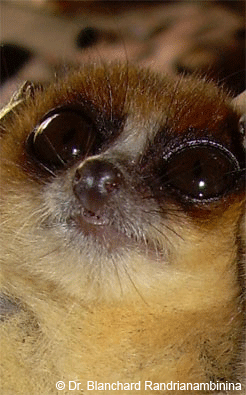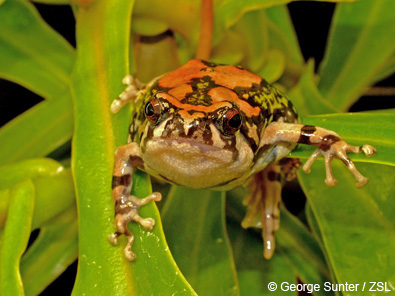Scientists have described a new species of mouse lemur from Madagascar, bringing the total number of known species to 16.
Madagascar is famous for its exceptional biodiversity, and has an incredibly rich endemic fauna in relation to its limited surface area. Many of the mammals, amphibians, birds and plants are extremely evolutionarily distinct; a result of having evolved in isolation for 165 million years.
Like all other lemurs, mouse lemurs are unique to Madagascar. They are small nocturnal solitary foragers that can be found in all habitats of Madagascar. The genus Microcebus includes the smallest of the lemurs and indeed the smallest of all living primates (the pygmy mouse lemur, Microcebus myoxinus, weighing around 50g with a head-body length of just 12-13cm). The newly described species, named Microcebus macarthurii, belongs to a group of larger bodied mouse lemurs, about the size of a grey squirrel. Scientists discovered the species whilst carrying out an inventory of the poorly-known montane rainforests of the Makira region of northeastern Madagascar.
To date, this generally unknown species has been sighted only in the Makira region. The scientists suspect that the natural range of the MacArthur`s mouse lemur is very small, as several large rivers and a mountain range cut through the region – these natural barriers could limit the mouse lemur’s distribution.
The new species is genetically distinct from the smaller Mittermeier`s mouse lemur, that occurs sympatrically in the same region. The study also indicated that there may be a second, as yet undescribed species of mouse lemur occurring in the region.
The research was carried out by Dr. Ute Radespiel from the Institute of Zoology of the University of Veterinary Medicine Hannover, Foundation (TiHo), in collaboration with Malagasy scientists and students of the GERP organisation (Groupe d`Étude et de Recherche sur les Primates de Madagascar). The results were published on the internet page of the American Journal of Primatology (Https://www.interscience.wiley.com/ajp, on July, 14th).
The Makira region, after these new findings, is one of the areas with the richest lemur fauna on Madagascar. Several EDGE lemurs also occur in the region, including the aye-aye (Daubentonia madagascriensis), indri (Indri indri) and hairy-eared dwarf lemur (Allocebus trichotis)
Dr. Radespiel said “Unfortunately, this exceptional centre of biodiversity is in real danger. As in many other regions of Madagascar, too, deforestation activities, slash-and-burn cultivation, hunting and mining of mineral resources pose an enormous threat to the remaining forests and their inhabitants. Conservation activities are urgently needed to ensure the long-term survival of these animals.”
The Madagascar Fauna Group (MFG) is an international collaboration of zoos and related organizations that work together to conserve the unique animals of Madagascar. To find out more about the organisation please click here.
The EDGE of Existence programme is hoping to work with Malagasy conservationists to develop an educational programme focusing on one of the top EDGE amphibians, the Malagasy rainbow frog (Scaphiophryne gottlebei). Number 37 on the EDGE Amphibians list, this colourful frog is found in the rocky canyons of the Isalo Massif in southwestern Madagascar. The frog’s brightly coloured appearance makes it a popular target for the pet trade, and thousands of individuals are captured each year, threatening populations in the wild. We aim to help develop educational programmes to raise awareness of the importance of conserving the species, and to encourage more sustainable harvesting for the pet trade.
To support our work in Madagascar please click here
For further information on Microcebus macarthurii please contact:
Dr. Ute Radespiel, Institute of Zoology
E-mail: ute.radespiel@tiho-hannover.de

